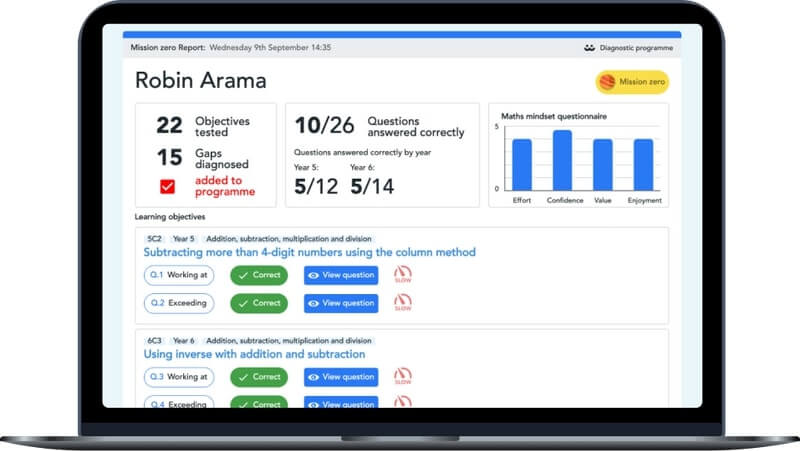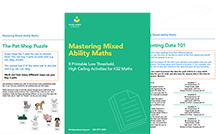Low Threshold High Ceiling Activities And Other Strategies For A Mixed Ability Classroom
So now you’re teaching a mixed ability class, here are some strategies that have worked for me, including my favourite – Low Threshold High Ceiling (LTHC) activities.
You’ve read the research, you’ve talked to your colleagues, and you know that mixed ability grouping is probably the right step for your classroom, but you may still be unsure about how you manage your mixed ability class, particularly in maths lessons, where progress and attainment can be so different.
Here are some practical strategies for managing a mixed ability classroom at primary and some maths activities to use in KS1 or KS2, with a focus around cooperative problem-solving in maths, which is where mixed ability can come into its own!
This article follows up on the ideas raised in mixed ability vs ability grouping in the primary school classroom. If you haven’t read it, read it now – we’re not alone in thinking that the concept of ability groupings in primary school within the new curriculum needs a general rethink.
It’s important to address the language we use to talk about ‘ability’ and ‘attainment’. Indeed, although ‘mixed ability’ is an oft-used phrase in the educational community (and within our blogs), it can carry the assumption that learning potential is fixed. Using terms such as ‘middle attainers’ can support a more developmental mindset.
Other recommended reading for those on their maths mastery journey:
- What Is Maths Mastery? The 10 Key Principles Of Teaching For Mastery In Maths
- Maths Mastery Toolkit And Resources: A Practical Guide
- Mixed Ability Teaching For Mastery
Low threshold high ceiling: Differentiated challenges for mixed ability maths teaching
When teaching mixed ability groups, there are challenges that can arise. The Wroxham School in Potters’ Bar has solved the mixed ability challenge with… challenges! In lessons, children are given the input as a whole class and then there are three challenges to pick from for the task.
Children self-select the task they feel best suits their confidence with the content. If they feel the challenge they picked was too hard or too easy, they are free to go back and pick another one.
This also involved a culture shift as children were taught to challenge themselves, but also not feel ashamed of picking the easier challenge if they want to. They can work through all 3 challenges during the lesson if they wish, therefore building confidence during a lesson.
Read more: Differentiation In The Classroom
Low threshold high ceiling: Planning carefully for mixed ability
This is no extra work for the teacher as it requires the usual 3 differentiated tasks, but without having to teach the content three ways. It takes some thinking about during the planning stage when you are first implementing this. However, once embedded, it becomes a very easy way to ensure everyone has the potential for not just grasping the basic concept, but also moving to a greater depth of understanding.
Of course, any child who needs extra help or support is given it, and assessment during and after the lesson ensures teachers act on gaps as soon as possible.

Meet Skye, the voice-based AI tutor making maths success possible for every student.
Built by teachers and maths experts, Skye uses the same pedagogy, curriculum and lesson structure as our traditional tutoring.
But, with more flexibility and a lower cost, schools can scale online maths tutoring to support every student who needs it.
Watch Skye in actionLow threshold high ceiling: Cooperative problem solving activities for mixed groups
An engaging way to manage mixed ability classes is to work together at the start by introducing a lot of cooperative problem solving. Especially starting with low threshold, high ceiling type activities.
Low Threshold High Ceiling Activities
The holy grail for your mixed ability classroom is low threshold high ceiling activities where the whole class gets to act like mathematicians, developing problem solving skills alongside conceptual understanding.
One of the associated benefits of LTHC tasks is classroom culture – because the whole class can work together there is nobody who ‘can’t do the maths’.
What are Low Threshold High Ceiling Activities?
Low Threshold High Ceiling Activities are maths investigations or activities where every individual in the group or class is able to find a way to engage with and answer the question at their own level.
The high ceiling means that there are always multiple opportunities for higher attainers or more confident learners to do more complex problem solving as part of the exercise or find alternative and more elegant solutions.
How to use Low Threshold High Ceiling Activities
Giving these out to mixed ability groups enables them to start working together. They can start by working it out on their own – each using their own methods – then compare in groups to see who has the most efficient method.
In some cases, you also find that the higher ability has tried so hard to think of some complex equation for it that they have not actually finished – and can learn a thing or two from a lower ability child who used their growth mindset to just get stuck in and tried loads of things until something worked!
Sometimes, particularly on US websites aimed at high school students, you’ll find these referred to as Low Floor, High Ceiling. The principle is the same.
How To Create Low Threshold High Ceiling Activities
There’s no question that for busy educators, it’s hard to find time to create enough different activities with a low threshold high ceiling that cover appropriate mathematical concepts for your year group.
Nrich and Youcubed.org have several on their sites, but they can be difficult to find.
To help you get started, I’ve gathered my favourite 8 LTHC tasks here for you in this Mastering Mixed Ability Maths resource pack; all of them have lots of possibilities in how to go about answering them. Don’t forget to download it for free!
Mastering Mixed Ability Maths Resource
8 Printable Low Threshold, High Ceiling Activities for Upper and Lower Key Stage 2 Maths - Curriculum Linked for Years 3, 4, 5, 6
Download Free Now!Here’s an example of one of my favourites.
Low Threshold High Ceiling Task: The Pet Shop Puzzle
This Pet Shop Puzzle is a great example of a low threshold, high ceiling task. It has been used from Year 2 up to Year 6 with great effect as a starter puzzle based on a real-life concept that all children can engage with.
No input from the teacher is needed – just let them go and see what they do.
It’s a great assessment piece too, just take notes on how each child approaches the puzzle to get an idea of how their maths brain is working!
Download the free Mastering Mixed Ability Maths Resource for printable teacher guidance on how to manage this activity and 7 other LTHC tasks.

For lots more fun Maths investigations KS2 like these, check out the following:
- Maths Investigations For KS2: How To Make Mathematical Detectives
- KS2 Maths Problem Solving Investigations Based On Real World Events In Primary Schools
- 2 Step And Multi-Step Word Problems In Maths
Low threshold high ceiling: Using master teachers to introduce maths talk
How about introducing master teachers into your classroom? Not the adult sort, but you can always make use of your high achievers and give them a role in helping other children on their tables.
This might be a role for every day (i.e. a child per table who is the Master Teacher and coaches or supports the other children) or it could be a badge handed out during a lesson for a child who has finished the work and shows good understanding.
The master teacher or teachers can then provide peer support to your lower ability pupils to help them understand concepts. Children often find their peers explain things in a way they can understand better than the teacher as they are closer to their level.
Low threshold high ceiling: More time for individual pupils
As well as giving the teacher more time to help children, it also helps embed the knowledge for the Master Teacher. By teaching it and seeing other children respond to it or not #, they will soon see if their own grasp is correct.
You can even give the children a table in the room where children who want support can see them and they can help them to grasp the concept.
It takes some time to set up to ensure the master teachers aren’t patronising and know how to actually teach something rather than just give out the answers. However, that input at the start is well worth it and if it becomes a school-wide policy, then year on year their teaching ability becomes first-rate!
Low threshold high ceiling: Reinforce important concepts from KS1 and KS2
Although the above ideas can really help to keep everyone working together and on the same content, there will invariably be some children who simply struggle with certain concepts.

individual pupils might be struggling with certain concepts
This may require some more outside help if you do not have the resources in school to support them individually.
There are plenty of options for maths interventions available including the AI maths tutoring that Third Space Learning provides.
It is essential, however, that whatever path you choose, the intervention has the capacity either to diagnose gaps or to allow you the class teacher or maths leader to decide what needs to be taught. Without this, you could be wasting your time and valuable resources.
And don’t forget to download your free Mixed Ability Maths Activity Pack
DO YOU HAVE STUDENTS WHO NEED MORE SUPPORT IN MATHS?
Skye – our AI maths tutor built by teachers – gives students personalised one-to-one lessons that address learning gaps and build confidence.
Since 2013 we’ve taught over 2 million hours of maths lessons to more than 170,000 students to help them become fluent, able mathematicians.
Explore our AI maths tutoring or find out about primary maths tutoring for your school.






